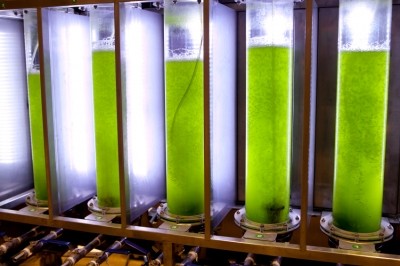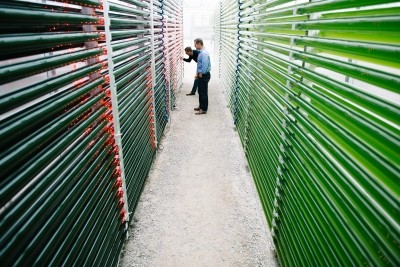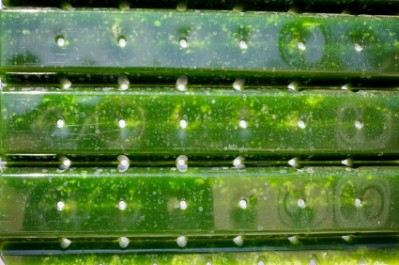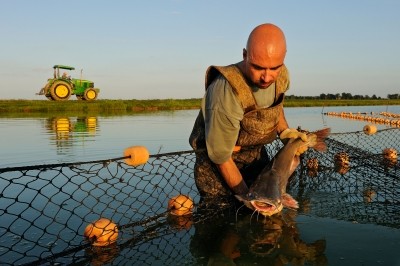Could algae meal replace corn-based feed?
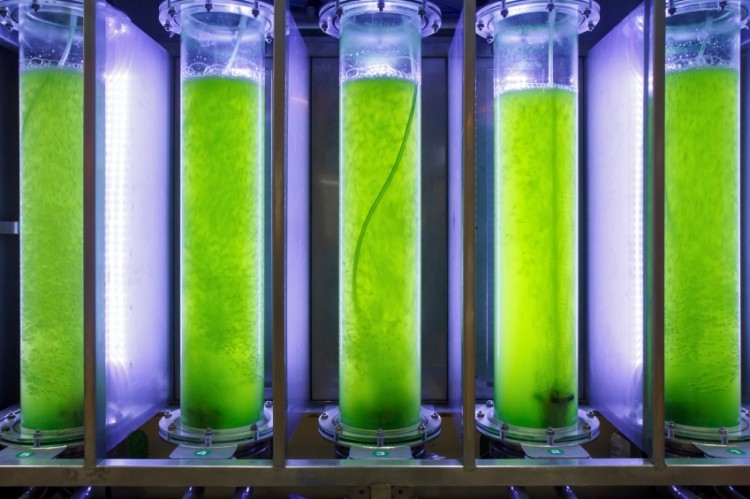
The researchers tested use of algae meal as part of a regular diet for cattle in series of three different research experiments and found that it boosted dry matter intake (DMI) and was digestible.
“The objectives of these studies were to determine the in vitro digestibility, preference, in situ disappearance, and performance of steers consuming increasing concentrations of ALG (algae meal) in concentrate-based diets,” wrote the researchers in the Journal of Animal Science. They added that because of its different makeup, it could be a possible replacement for corn in the diet.
“Overall, these studies suggest that ALG is highly digestible in concentrate-based diets and could potentially be used as an alternative energy feedstuff in beef feedlot diets. The digestibility studies indicate that ALG is readily digested within the rumen and is intermediate in digestibility between corn and soyhulls,” they reported.
“Additionally, these data suggest that ALG may make an excellent feed ingredient in grower cattle diets, as feed intake was stimulated when greater amounts of ALG were included in the diet,” they added.
The research project was partially funded by Solazyme.
Details of the algae meal
“Looking at the nutritional analysis of the algae meal we saw a combination of fiber (able to be used by cattle), fat (for energy), and protein (for growth),” Stephanie Hansen, associate professor of beef feedlot nutrition at Iowa State University told FeedNavigator. “While some algae products have too much protein or a lot of minerals like iron or aluminum, we didn’t see that with this product, so we knew we had the opportunity to feed it at greater inclusions than previously studied algae products.”
The meal is a mixture of dried, deoiled microalgae bodies and soyhulls and offers a nutrient makeup that is unique from other microalgae feed products, the scientists said. Unlike a pure microalgae product, the substance being tested is comprised of 57% microalgae.
“Because of its favorable nutrient profile, we hypothesized that replacing energy feedstuffs with ALG would have no effect on cattle DMI or growth,” said researchers.
Experiment details
In all three experiments, four diets were used – a control diet of wet corn gluten feed and the control diet with 15% algae meal, 30% algae meal and 45% algae meal substituting part of the corn in the dry matter (DM), stated the study. Before starting the experiments, preliminary work was done to determine it the meal was digestible at the levels used in the trials.
The first trial sought to determine steer preference of the meal, said the researchers. In it, the steer were fed a pairing of the four diets for six separate, five day intervals. Each diet offered amounted to half of the day’s ration and the troughs were inspected every hour for the four hours after initial feeding. A DMI for each steer was determined.
In the second experiment the four diets were delivered for four 14-day intervals. Dacron bags were inserted on day 13 of the trial, they said.
Corn, algae meal, soyhulls and hay were ground and added to duplicate bags in the rumen at 0, 12, 24, and 30 hours to determine estimates of DM disappearance at different times, they said. All bags were removed at 36 hours. Rumen pH was measured at six hours post feeding on the final day of the study.
“Absolute rate of digestion represents the percent of DM digested per hour for the 36-h digestion experiment,” researchers said.
The third test compared the growth and DMI of 48 steers receiving one of the four diets. For the trial, steers were split into one of eight pens and fed a series of intermediate diets before starting one of the four diets used in all the experiments, they said in the study. The steer received the final diet for 55 days. They they were weighed at the start, on days 26 and 27 and at the end. Average daily gain was established as were DMI and the gain:feed (g:f)ratio for each steer.
Results
The first experiment demonstrated, in terms of total DM consumed, that steers favored a diet with 15% or 30% algae meal, when they were paired with a diet that included 45% algae meal, researchers said.
During the four-hour window, there was a “diet x hour” effect as during the first hour, cattle tended to start with the control diet or 15% algae meal diet compared to either the 30% or 45% diets. By the fourth hour, the trend was for more of the 15% or 30% diet to be eaten than the control diet, they said.
In the second experiment, no change was found on the rumen pH six hours after feeding, nor did the researchers report finding that diet or diet x hour altered the “ruminal disappearance of algae, corn, hay or soyhulls.” However, the overall DM disappearance did increase the longer it was in the rumen and the algae meal increased the rate of disappearance during the time window. But, they added, there was “no effect of experimental diet on the absolute rate of disappearance of the bromegrass hay or soyhulls.”
“The disappearance of (algae meal), as well as the lack of differences in rumen pH measured at six hours postfeeding, suggests no discernible negative impacts on the rumen environment, indicating ALG could serve as a viable feedstuff in cattle diets,” researchers concluded.
The final experiment did not see the steers’ midpoint or ending BW change by addition of the algae meal, researchers said. There was a linear increase in DMI as the algae meal increase in the diet and for the first 27 days steers getting 15% and 45% algae meal saw an improved average daily gain. Additionally, the average daily gain linearly improved as the amount of the algae meal increased.
The largest DMI overall was for steer getting 45% algae meal at 8.85kg/d compared to 7.19 kg/d from the steer getting the control diet, reported the study. However, feed efficiency decreased during the study.
However, results also suggest that the product needs additional moisture to be used to the best effect, Hansen said.
“One thing we learned was that the product is so dry that if you want to feed higher inclusions you need some wet ingredients in the diet to help mix the diet and increase palatability to the animal,” she said.
What’s next
After the three-experiment project, the research team ran another study with finishing cattle, said Hansen. Information gathered in that work is in the process of being published.
“As we move forward, the logical next step is to continue to refine the feeding value of the algae meal for cattle under a variety of feeding conditions such as roughage vs. concentrate based diets so that beef producers understand how to take advantage of the product,” she said.
Source: Journal of Animal Science
Title: Determining the preference, in vitro digestibility, in situ disappearance, and grower period performance of steers fed a novel algae meal derived from heterotrophic microalgae
DOI: doi:10.2527/jas.2014-8654
Authors: M. L. Van Emon, D. D. Loy and S. L. Hansen
